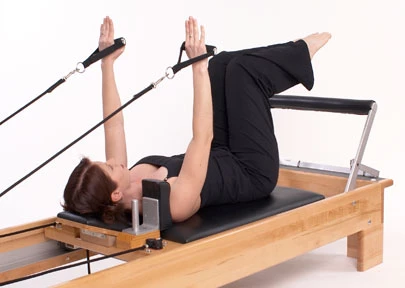
Pilates was founded by Joseph Pilates (1880-1967) as a system of fitness exercises that is still practiced in more or less modified forms. In the last two decades, there has been a significant increase in the popularity of Pilates-inspired exercises.
What is Pilates?
Pilates is a form of exercise where emphasis is placed on control of body position and movement. Generally exercises use a reformer (see picture below), an adjustable spring based resistance piece of equipment. Exercises can also be floor based. Traditional principles of Pilates exercise include centering, concentration, control, precision, flow, and breathing.

A reformer being used
Image taken from: http://www.highlightfitness.com.au/wp-content/uploads/2014/04/pilates-reformer-image.jpg
Previously exclusively used by dancers, Pilates is becoming popular in the mainstream exercise arena and in injury rehabilitation for both females and males. Pilates has been well researched and as a result is frequently prescribed to people who suffer, but not restricted to:
Balance difficulties
- Pilates is effective in improving static (when still) and dynamic (when moving) balance and balance confidence in older adults. Josephs
Cardiovascular conditions
- Pilates training provides a functional capacity grain in cardiovascular disease (such as heart failure) compared to conventional exercises (walking), importantly, with no additional adverse event risk.
Cross-training for other sports
- Professional athletes from such sports as Rowing, AFL, Rugby League and Union, and Soccer utilise Pilates to prevent injuries. (rumball, moirera, brukner, bridgens)
Overall Healthy:
- Pilates is a form of exercises which can proactively reduce the incidence of musculoskeletal-related pathologies (Wells)
Lower back pain:
- A Pilates exercise program yields improvements in the level of pain and postures of sufferers of non-specific low back pain (Patti)
- Pilates has been reported to reduce pain and disability in people with chronic low back pain (Wells)
Mental Health
- Pilates, as a form of physical activity has been shown to maintain, enhance and ameliorate mental health in sufferers of severe mental illness such as depression, and anxiety. (Pernham)
Neurological conditions
- Pilates is beneficial to sufferers of Parkinson’s Disease (PD) or Multiple Sclerosis who are prone to falls, with significant improvements to balance, mobility and greater confidence in activities of daily living (Johnson, Freeman)
Painful joints
- Pilates has been shown to improve the level of function of sufferers of patients with knee and hip osteoarthritis (Baltaci).
- Following total hip or knee replacements, Pilates can be incorporated without early complications to improve level of function. (Levine)
Recurring Injuries
- Pilates has been implemented by professional sporting teams to reduce the incidence and reccurence of low back, hip-related (hamstring and groin) injuries. (Brukner)
Pilates is offered at xPhysiotherapy 6 days a week, across various times of the day (see timetable). An initial assessment with a physiotherapist is compulsory to gather information pertinent to your history, evaluate baseline postures and movement patterns, and to ensure your safety before beginning. Well-trained Pilates instructors and physiotherapists will prescribe personalised exercisesin an hourly class based on the information from the assessment. All of this intends to positively influence your health and wellbeing. Pilates at Xphysiotherapy may also be private health rebateable. It is advisable to check with your private health insurer, as they may offer a living well benefit or similar for Pilates-based exercise.
References
Baltaci, G. (2006). Comparison of strength, functional outcome and proprioceptive ability after pilates-based exercise program in women patients with knee osteoarthritis. Faculty of Health Sciences, Dept of Physiotherapy and Rehabilitation.
Bridgens, S. (2013). The role of Pilates in preventing injuries in soccer players.
Brukner, P., Nealon, A., Morgan, C., Burgess, D., & Dunn, A. (2013). Recurrent hamstring muscle injury: applying the limited evidence in the professional football setting with a seven-point programme. British journal of sports medicine, bjsports-2012.
Freeman, J. A., Gear, M., Pauli, A., Cowan, P., Finnigan, C., Hunter, H., … & Thain, J. (2010). The effect of core stability training on balance and mobility in ambulant individuals with multiple sclerosis: a multi-centre series of single case studies. Multiple sclerosis.
Guimarães, G. V., Carvalho, V. O., Bocchi, E. A., & d’Avila, V. M. (2012). Pilates in heart failure patients: a randomized controlled pilot trial. Cardiovascular therapeutics, 30(6), 351-356.
Johnson, L., Putrino, D., James, I., Rodrigues, J., Stell, R., Thickbroom, G., & Mastaglia, F. L. (2013). The effects of a supervised Pilates training program on balance in Parkinson’s disease.
Josephs, S., Pratt, M. L., Meadows, E. C., Thurmond, S., & Wagner, A. (2016). The effectiveness of Pilates on balance and falls in community dwelling older adults: a randomized controlled trial. Journal of Bodywork and Movement Therapies.
Patti, A., Bianco, A., Paoli, A., Messina, G., Montalto, M. A., Bellafiore, M., … & Palma, A. (2016). Pain Perception and Stabilometric Parameters in People With Chronic Low Back Pain After a Pilates Exercise Program: A Randomized Controlled Trial. Medicine, 95(2), e2414.
Levine, B., Kaplanek, B., & Jaffe, W. L. (2009). Pilates training for use in rehabilitation after total hip and knee arthroplasty: a preliminary report. Clinical Orthopaedics and Related Research®, 467(6), 1468-1475.
Moreira, A., Bilsborough, J. C., Sullivan, C. J., Cianciosi, M., Aoki, M. S., & Coutts, A. J. (2015). Training periodization of professional australian football players during an entire Australian Football League season. International Journal of Sports Physiology & Performance, 10(5).
Perham, A. S., & Accordino, M. P. (2007). Exercise and functioning level of individuals with severe mental illness: a comparison of two groups. Journal of Mental Health Counseling, 29(4), 350.
Rumball, J. S., Lebrun, C. M., Di Ciacca, S. R., & Orlando, K. (2005). Rowing injuries. Sports medicine, 35(6), 537-555.
Wells, C., Kolt, G. S., & Bialocerkowski, A. (2012). Defining Pilates exercise: a systematic review. Complementary therapies in medicine, 20(4), 253-262.

